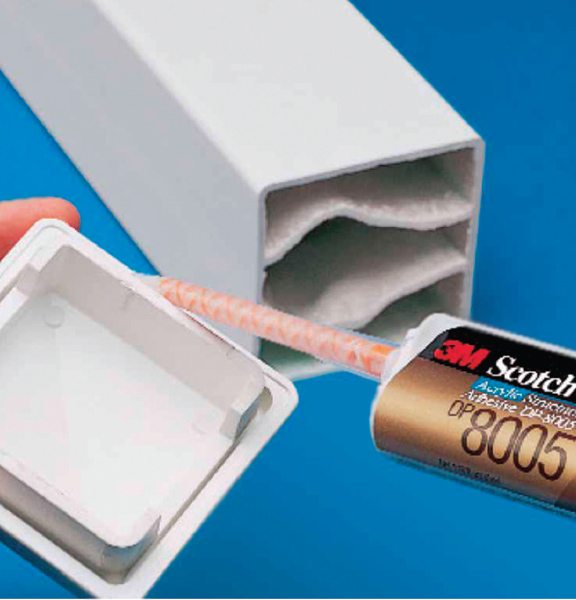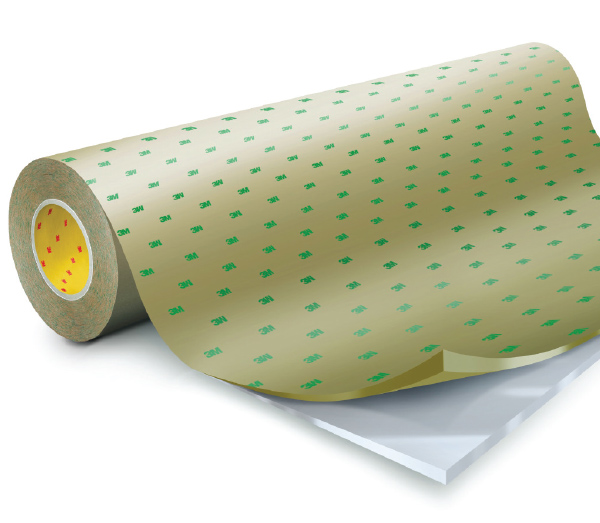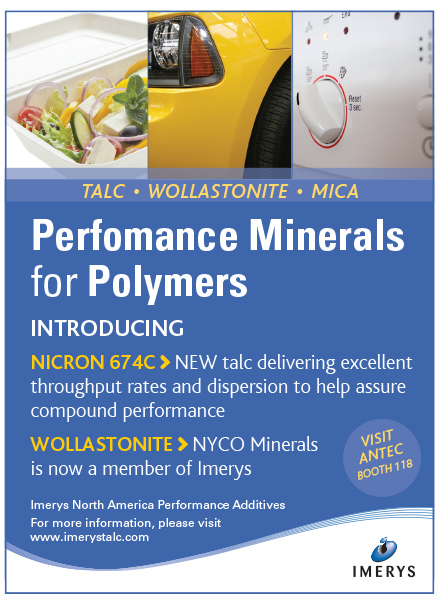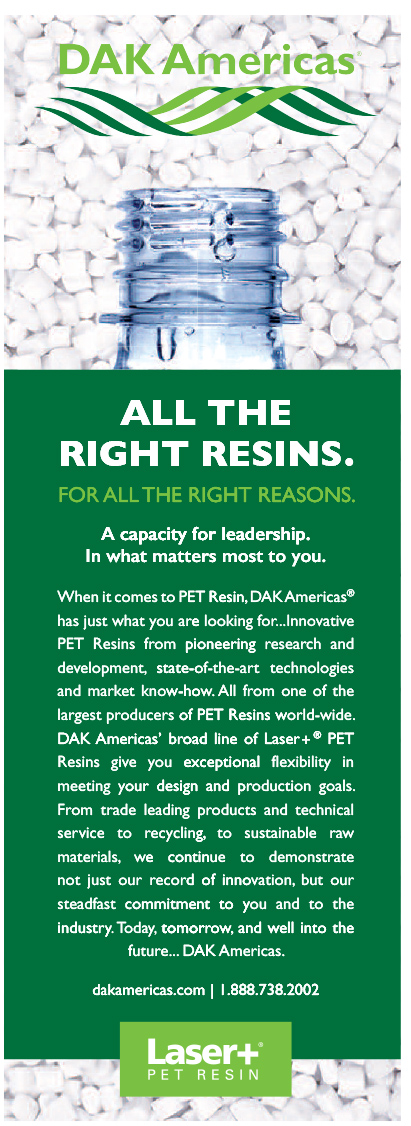Plastics and Composites Bonding with Adhesives and Tapes
Even difficult-to-bond plastics can be joined together with the proper adhesive
Previous Article Next Article
By Shari Loushin, 3M Company
St. Paul, Minnesota, USA
Plastics and Composites Bonding with Adhesives and Tapes
Even difficult-to-bond plastics can be joined together with the proper adhesive
Previous Article Next Article
By Shari Loushin, 3M Company
St. Paul, Minnesota, USA
Plastics and Composites Bonding with Adhesives and Tapes
Even difficult-to-bond plastics can be joined together with the proper adhesive
Previous Article Next Article
By Shari Loushin, 3M Company
St. Paul, Minnesota, USA

A 3M™ Scotch-Weld™ Structural Plastic Adhesive in a Duo- Pak cartridge with a disposable “static mix” nozzle being applied to a plastic part (photo courtesy of Industrial Adhesives and Tapes Division, 3M Company).1

Polypropylene and other difficult-to-bond LSE plastics can be joined together with a pressure-sensitive adhesive like 3M’s 300LSE.

Scotch-Weld Structural Plastic Adhesive DP8010 Blue is used to bond LSE plastics in applications like medical equipment and panels for small-engine-based tools.
As it becomes more common for manufacturers to use plastics or composite materials as alternatives to traditional metals in design and assembly, production techniques must evolve to accommodate new potential challenges that may arise.
The advantages of switching from an all-metal assembly to using plastics and composites are numerous and well recognized. Using plastics and composite materials in assembly increases durability and provides aesthetic value that was not always possible with all-metal designs. Plastics and composites are usually lighter in weight than metal; so designing with these alternative materials provides a lighter overall product, which can save on shipping costs and energy in end-uses for vehicle-related items. In addition, using composites and plastics can lower production costs, as less finishing and painting is typically required.
While rivets and bolts typically work well for metal-on-metal bonding, they aren’t always effective when bonding plastics or composite materials. These traditional mechanical fasteners risk damaging the non-metal substrate and place all of the load-bearing stress at one small point. This can be especially damaging for more ductile plastic materials where stress may lead to enlarging the through-holes, or for composites that may crack or craze when exposed to drilling. Also, the fasteners often result in poor aesthetics.
Various plastics welding techniques are also available, but can be limited in their use. In some cases, challenges can exist in bonding dissimilar plastics or plastics to metals. Initial equipment costs are high, tooling costs can be cost-prohibitive for short runs, and for some methods, part geometries are limited. Final appearance can be excellent, but sometimes additional finishing is still required.
As an alternative solution, manufacturers are leaning more heavily on the use of adhesives and tapes to bond their materials in assembly. Adhesive and tape bonding addresses many of these issues, such as allowing virtually any geometry to be bonded with low equipment costs; distributing stress across an entire bond-line instead of concentrating it at certain points; and allowing any combination of substrates to be simultaneously bonded and sealed.
When presented this way, it seems clear that adhesives are the superior choice for bonding composites and plastics in assembly. However, using adhesives and tapes can come with another set of challenges that are important to understand and learn how to overcome.
General Plastics and Composites Bonding
Some plastics and composites don’t present any problems when bonding with adhesives. There are a number of options for bonding on the market that provide excellent strength to plastics such as ABS, polycarbonate, PVC, and acrylic and many traditional composites such as SMC or carbon fiber-reinforced epoxy composites.
Adhesive and tape bonding options range from solvent-based spray adhesives, through properly formulated hot melts, to cyanoacrylate (instant) adhesives and two-part acrylic structural adhesives. In many cases, double-coated thin or foam tapes can be used for no-mess, instant bonding with excellent aesthetic results.
The choice of which technology to choose will depend on the end-use application as well as production preferences; however, for most cases, several choices are available for these relatively easily bonded plastics.
For heavier-duty applications such as composite parts for sporting goods or highly stressed components of vehicles, a structural adhesive may be needed to ensure both high interfacial strength and high load-bearing performance. An epoxy works well for epoxy-based composites, for example.
For lower-load applications, such as plastic trim and molding, a more convenient and cost-effective choice may be a specialty hot-melt adhesive or a tape option such as 3M VHB™ acrylic foam tapes or thin bonding tapes. Small parts can be quickly but securely bonded with cyanoacrylates in industries ranging from medical devices to toys.
However, there are certain hard-to-bond materials that may require extra attention for excellent adhesion. Examples of these materials are low surface energy (LSE) plastics or composites, and sensitive materials such as foamed plastics.
Low Surface Energy (LSE) Plastics
LSE plastics can come in many forms, including thermoplastic polyolefin (TPO), HDPE, polypropylene (including glass-filled composites), and some powdercoats. Thermal methods such as friction or ultrasonic welding work well with these materials, but these methods can be costly and therefore not ideal for small updates or products that require frequent changes in design. Also, these methods may not work when these substrates are bonded to dissimilar materials.
Therefore, bonding with adhesives and tapes is often the ideal solution. That said, properly bonding LSE plastics has traditionally required substantial time and effort to be spent on preparation steps such as primers or plasma or corona treatments to energize the substrate surface. Fortunately, specialty adhesives and tapes can bond these materials without the need for expensive surface-preparation steps.
An example of a specialty adhesive is 3M Scotch-Weld Structural Plastic Adhesive DP8010 Blue, which can bond LSE plastics in a variety of applications, including medical equipment and panels for small-engine-based tools. Specialty adhesives are ideal options compared to traditional bonding methods because they allow the combination of virtually any substrate. And design changes can be made on a whim without incurring too much additional expense.
Polypropylene and other plastics can be difficult to bond, but pressure-sensitive adhesives such as 3M’s 300LSE are designed specifically to successfully bond these materials. These pressure-sensitive tapes bond quickly and are well equipped to tolerate heat and humidity. Pressure-sensitive tapes also allow a wide variety of suitable substrates to be used in assembly; 3M 300LSE in particular is a proven solution for plastics assembly in a broad spectrum of markets, including electronics and automotive.
Expanded Foam
Used commonly in industries such as construction and packaging, expanded foam panels are low in weight and rigid, and have ideal insulation properties. They are typically made from expanded polystyrene (EPS) or expanded PVC. Unlike LSE plastics, expanded foam is not hard to bond because of its surface energy level. Instead, these foams are extremely susceptible to damage from traditional bonding methods, as well as heat and solvents, and their very nature makes them extremely subject to damage and pull-out from fasteners that pierce them.
Despite the sensitivity of expanded foams, they can be bonded using designated solvent- or water-based spray adhesives, low-temperature melts, or pressure-sensitive tapes. The non-destructive nature of these adhesives provides immediate adhesion when bonding expanded foam.
EPS foam specifically requires that the adhesive only has to be as strong as the substrate. This often makes a lower-strength spray adhesive that uses propellants and solvents that will not dissolve the EPS an appropriate choice. A web spray pattern gives an adhesive the ability to stand up on the surface, which helps counteract irregularities and surface roughness from EPS beads that are used in construction.
Foam is often used as insulation attachments on transportation vehicles, which can often lead to problems with high temperatures from sun exposure. The proper adhesive will allow the insulation to withstand these conditions.
A low-temperature melt adhesive is another option for bonding expanded foam. These adhesives provide unprecedented strength and adhesion within seconds, which can speed up the production process. Also, low-temperature melts have high heat resistance and low creep.
Contrary to standard hot-melt adhesives, which are applied at temperatures around 350°F (177°C), low-temperature melts do not risk melting expanded-foam structures. Low-temperature melts provide the same heat-resistance abilities as standard hot melts, but use polymer blends that melt at lower temperatures.
Specialty low-temperature melt adhesives are designed to provide control on irregular spaces, including those that are porous, curved, or three-dimensional. For this reason, low-temperature melts are ideal for furniture and product assembly, packaging applications, foam spacers, and countertop displays.
Selecting the Right Adhesive
Adhesives are a great solution for all kinds of assemblies, but it’s very important to select the correct adhesive for the project at hand. Adhesive selection is a process, and what might work for one project may not work for another, so reliable technical information is critical.
Qualified suppliers will provide counsel for you based on your specific needs, and can point you in the right direction for an adhesive chemistry that will provide you with the most efficient process and best quality for the finished product. Because there are so many adhesive options, it’s important to consider the following questions when deciding on which adhesive to select for your project:
- Which joints or surface characteristics are going to require thought in this assembly?
- Which materials am I trying to assemble, and what adhesive will work best with my chosen substrates?
- How do I plan to use this adhesive in the assembly process?
- What is the end-use goal for this product?
- Which adhesive will best help me reduce my cost, or make the most of my budget?
When an engineer transitions to adhesives and tapes from more traditional bonding methods, he or she will probably need to go through a qualification period. During this period, the engineer will do trial runs with different types of adhesives to work toward identifying which is best for the project at hand. This qualification period is especially critical for projects that require the use of hard-to-bond substrates.
Choosing a partner that not only offers a broad spectrum of adhesive options—but also helps narrow-down options based on individual project needs—helps engineers cut both time and costs. A good provider will give advice on testing protocols and how to perform screening tests in order to help the engineer save further expense during this period, and avoid choosing any adhesive besides the one that’s best suited for the individual project.
Reference
1.“Innovations in Bonding to Low Surface Energy Surfaces,” Industrial Adhesives and Tapes Division, 3M Company, 2015.
About the author… Shari Loushin is senior technical service specialist, Structural Adhesives, at 3M Company.

